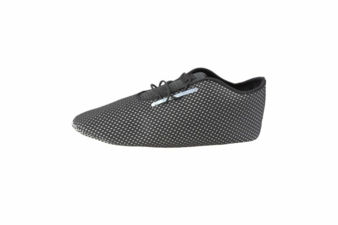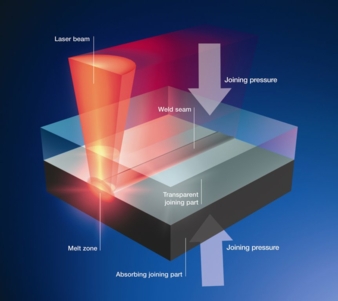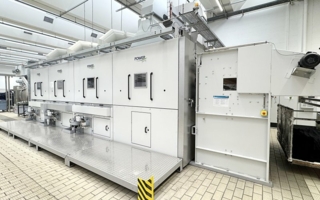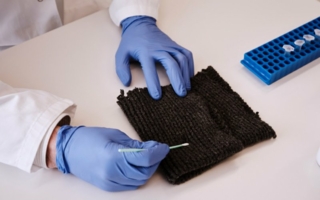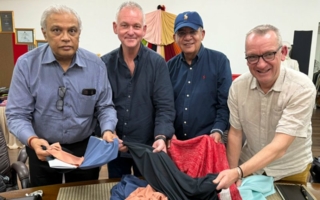05/05/2017 – Leister Technologies AG — auf Deutsch lesen
Laser welding of textiles
Laser welding is a brand new technology that is not yet being used for industrial manufacturing in the field of apparel production.
Leister produces plastic welding equipment and laser systems, and has extensive experience with the welding of thermoplastic synthetic materials. The Swiss company has been researching laser technology for many years, and has now developed a textile laser welding machine that works similar to a normal sewing machine. This high-end piece of equipment is currently being used for the production of apparel prototypes.
The benefits of laser-welded textiles are readily apparent
There is no damage whatsoever to the exterior of the textile material, creating a seamless effect. Laser-welded seams are extremely flat, elastic, and skin-friendly. Since laser welding does not require adhesives of any kind, it is also especially environmentally friendly due to the recycling process.
But how does laser welding work exactly? Leister works with IR laser systems. Here the optical characteristics of the textile material in the invisible spectral range are relevant. Both an IR-absorbing and a non-IR-absorbing textile material are needed to create seams of high quality. Working with 2 non-IR-absorbing fabrics is possible as well. However, an IR absorber applied either by means of ink jet printing or manually is in part required in this case.
Furthermore, the two thermoplastic materials being welded have to be the same. This means PET only joins reliably with PET, PP only with PP, and so on. Leister has done well with PA6. Numerous tests have also been successfully conducted with PA66. However, blends such as 80% PES and 20% EL are possible as well. What can be welded together well or not depends mainly on the underlying laws of physics. Out-of-the-box thinking is essential for using this innovative technology. Companies with a pioneering spirit have a unique opportunity to develop their own know-how in this field.
Frederike Lehmeier, development engineer at Leister Technical Textiles & Industrial Fabrics: “We have done a lot of research in order to get where we are today. Our experience with laser plastic welding accumulated over many years was advantageous. We already knew how to create firm connections with the help of lasers. However, numerous other strict requirements have to be met for textiles.”
These depend on the concrete application. In the clothing industry for example, this means the product has to be washable and very comfortable to wear. Since the textile is flexible in comparison to plastic, the textile itself is a challenge, too. Frederike Lehmeier sees great potential in the sports technology field: “Sportswear in direct contact with the skin is exposed to stresses and perspiration. Other focal points may include breathability, skin friendliness and the feel in general.”
Aesthetics also have to be considered. The article of clothing should not only be functional but look good as well. Here the color and structure also play a role. In selecting the materials, the designer has to remember that the weldability of the materials being joined is a prerequisite for the laser technology. This means one has to mentally laser-weld the article of clothing once in the planning phase in order to see whether this is possible. The manufacturing process therefore begins with the careful selection of materials, which is a challenging process that requires extensive knowledge.
But this is not a disadvantage. Once a suitable combination of materials is found, the manufacturer is able to successfully fill a niche. Laser welding may first create the impression of stumbling over restrictions. Frederike Lehmeier: “I can imagine that laser welding may be substituted for gluing applications and take over aspects of classic sewing. However, I do not expect an established technique to be simply replaced by laser welding. This innovative technique is a supplement for the textile industry. It opens up entirely new possibilities for designers that could not be implemented in that form before. These have to be identified, and we support companies along the way with our knowledge.”
The company’s target group could be athletes who put a premium on comfort and performance, but also other customers who want to enjoy ultimate wearer comfort thanks to the smooth, soft laser seams. Undergarments such as bras or bustiers are made even more comfortable with laser welding.
The possibilities are varied. Next to the classic clothing industry, the field of wearables may also be important in the future. In this market segment in particular, a secure connection is becoming more important than ever before for the production of hybrids, for example when sensors or other technical components have to be integrated into clothing.
Leister at Techtextil 2017 Hall 3.0 Booth H03
Links:
https://www.leister.com/de-ch/laser-plastic-welding/textilindustrie
https://www.leister.com/de-ch/plastic-welding/technische-textilien-industriegewebe

